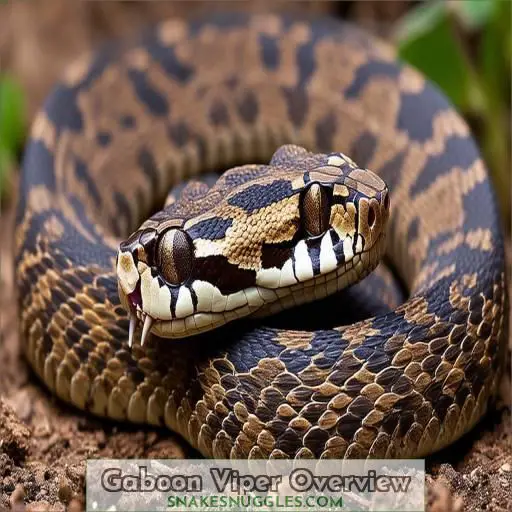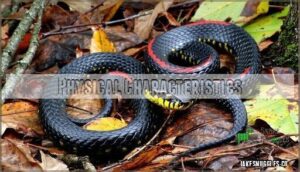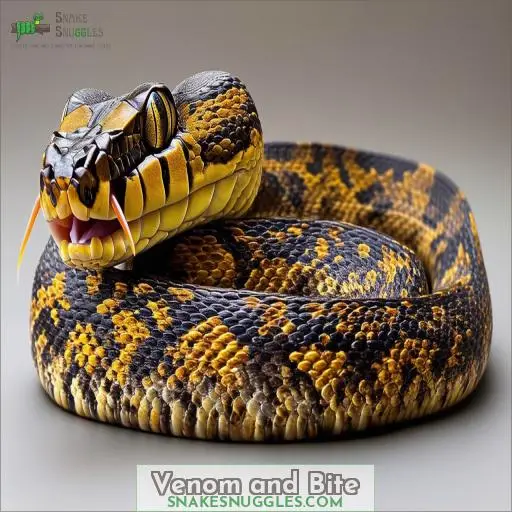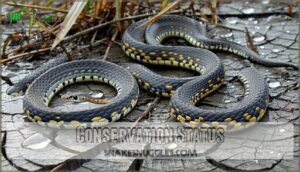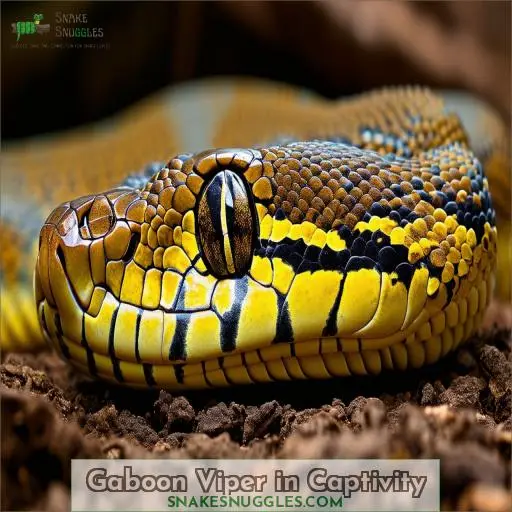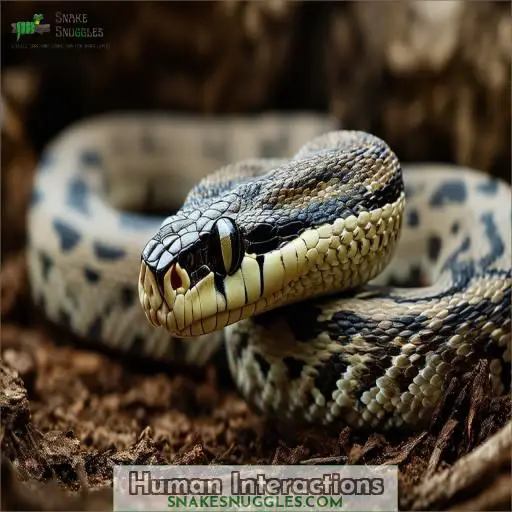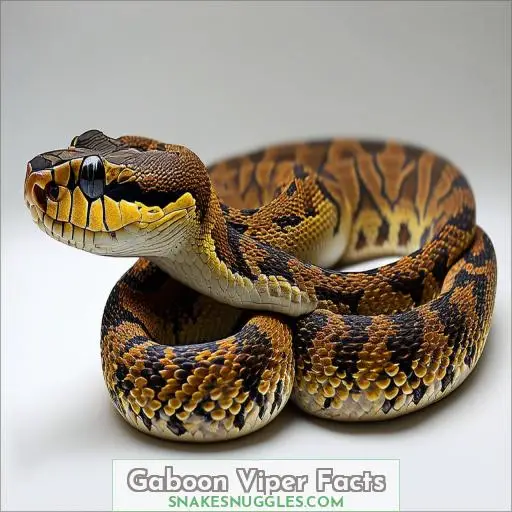This site is supported by our readers. We may earn a commission, at no cost to you, if you purchase through links.
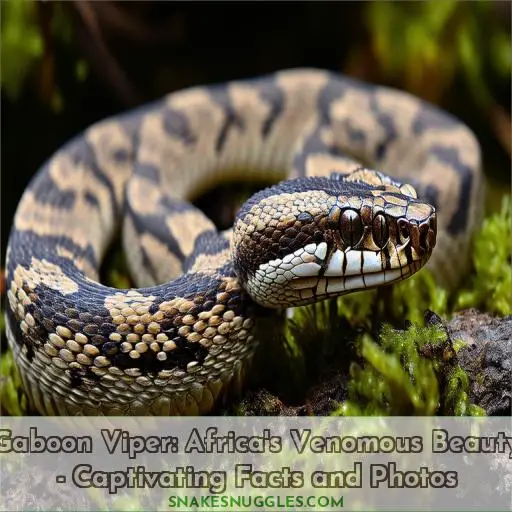 Prepare to be captivated by the gaboon viper, Africa’s venomous beauty!
Prepare to be captivated by the gaboon viper, Africa’s venomous beauty!
This extensive guide reveals fascinating facts and stunning photos of this iconic reptile.
You’ll discover its striking size, coloration, and distinct head shape.
Explore its geographic range across sub-Saharan Africa and preferred habitats.
Unravel the potent venom composition, bite symptoms, and antivenom treatment.
Dig into the gaboon viper’s remarkable behavior, from ambush hunting to defensive displays.
Gain insights into its conservation challenges and captive care requirements.
Table Of Contents
- Key Takeaways
- Gaboon Viper Overview
- Physical Characteristics
- Geographic Distribution
- Venom and Bite
- Behavior and Temperament
- Conservation Status
- Gaboon Viper in Captivity
- Human Interactions
- Gaboon Viper Facts
- Photo Gallery
- Frequently Asked Questions (FAQs)
- What are three facts about gaboon vipers?
- What is the largest Gaboon viper ever recorded?
- What would happen if you got bit by a Gaboon viper?
- Is the Gaboon viper the most venomous snake?
- How long can Gaboon vipers live in captivity?
- Do Gaboon vipers make good pets?
- What predators hunt Gaboon vipers in the wild?
- At what age do Gaboon vipers reach maturity?
- How much do Gaboon viper babies weigh at birth?
- Conclusion
Key Takeaways
- Feast your eyes on the gaboon viper, a true heavyweight champion of the snake world! Tipping the scales at a whopping 45 pounds, it’s like encountering a mini-anaconda slithering through the African rainforest. Talk about an absolute unit!
- These venomous beauties are masters of camouflage, blending seamlessly into their leafy surroundings with intricate patterns and earthy hues. It’s like they’re rocking the latest camo gear from Mother Nature’s fashion line.
- Don’t let their lazy demeanor fool you – these ambush predators can pack a serious punch with their potent venom cocktail. One bite could leave you feeling like you just got sucker-punched by Mike Tyson in his prime.
- While they might not win any popularity contests, gaboon vipers deserve our utmost respect and protection. After all, who wouldn’t want to preserve such a unique and formidable member of Africa’s wild kingdom?
Gaboon Viper Overview
You’re about to encounter one of Africa’s most alluring vipers – the Gaboon viper.
This venomous beauty is no stranger to the rainforests of sub-Saharan Africa, where it thrives as an ambush predator. Imagine a placid hunter lying in wait, camouflaged by its stunning patterns, patiently awaiting the opportune moment to strike at unsuspecting prey like rodents or birds.
With a diet suited for small-to-medium sized mammals, the Gaboon viper injects a potent venom capable of subduing its meal. Yet, despite its formidable reputation, these snakes rarely bite humans unless provoked or stepped on accidentally.
In captivity, they dine on a steady supply of mice and rats, making them a fascinating species to observe at esteemed institutions like the Smithsonian’s National Zoo.
Physical Characteristics
The Gaboon viper’s commanding size sets it apart, with lengths reaching an impressive 6 feet and hefty weights exceeding 45 pounds. Its stunning coloration showcases a palette of earthy tones adorned with intricate patterns of diamonds, triangles, and hourglasses, expertly camouflaging the viper within its natural surroundings.
Size and Weight
Imagine holding a massive, thick-bodied snake in Africa’s wilds, marveling at its incredible size and weight—reaching lengths up to 6.5 feet long and weighing a staggering 45 pounds! These venomous beauties, found across sub-Saharan Africa, grow to truly impressive proportions.
Coloration and Patterns
You’ll marvel at the gaboon viper‘s coloration and patterning—a clever camouflage for rainforest living. Dense, diamond-shaped markings in earthy, neutral colors allow these vipers to blend seamlessly with their surroundings.
Head and Body Shape
You’ll be captivated by their massive, leaf-shaped heads – complete with rostral horns and keeled scales. These large, venomous snakes have distinct triangular heads atop thick, heavy bodies. A dark line connects their forbidding appearance, warning of their deadly potential.
Geographic Distribution
The Gaboon viper is found across sub-Saharan Africa, inhabiting a wide range of habitats, from lowland rainforests and savannas to marshes and montane regions. These venomous snakes thrive in diverse environments, seeking damp, densely vegetated areas that provide ample cover and prey sources.
African Range
You’ll find these striking vipers throughout sub-Saharan Africa’s tropical regions – from West to Central Africa’s lush rainforests. Unfortunately, their African habitats face threats like deforestation and climate change impacting ecosystems. Protecting these areas is critical for conserving gaboon viper populations and minimizing potentially deadly human-snake encounters in local communities.
Habitat Preferences
You’ll find these massive vipers thriving in Africa’s wet and humid regions. They prefer the forest floor, lurking amid leaf litter and undergrowth, where their cryptic patterns provide perfect camouflage. However, their habitats face threats from:
- Deforestation
- Climate change
- Prey depletion
- Human encroachment
Conservation efforts are indispensable to protect their preferred haunts.
Venom and Bite
The gaboon viper’s venom is a potent mix of neurotoxins and hemotoxins, capable of causing severe pain, swelling, necrosis, and potentially life-threatening complications. If bitten, seeking immediate medical attention and administration of the appropriate antivenom are essential, as the snake’s large size and tendency to inject significant amounts of venom can make its bites particularly dangerous.
Venom Composition
The Gaboon viper’s venom contains potent neurotoxins and hemotoxins. Here’s its venom composition:
| Component | Effect |
|---|---|
| Hemorrhagins | Tissue damage, bleeding |
| Procoagulants | Abnormal clotting |
| Cytotoxins | Cell destruction |
| Neurotoxins | Paralysis |
While deadly, its venom holds potential medical applications if studied further.
Bite Symptoms
A bite induces excruciating pain, swelling, and in severe cases:
- Necrosis (tissue death)
- Hemorrhaging (uncontrolled bleeding)
- Nausea and vomiting
- Respiratory distress
Quick treatment is imperative for avoiding permanent injury or death.
Antivenom Treatment
If bit, antivenom treatment is essential – it’s the sole means to neutralize the viper’s potent venom. But treatment must be swift, as delays risk severe necrosis or fatal bleeding. Even with antivenom, recovery can be lengthy and side effects like serum sickness may occur. But it significantly improves survival chances.
| Availability | Effectiveness | Side Effects | Research Needs | Access Issues |
|---|---|---|---|---|
| Limited supply in some regions | Highly effective if given promptly | Serum sickness, anaphylaxis | Improving safety, shelf-life | Cost, logistics challenges |
| Stockpile issues | Reverses hemorrhaging, necrosis | Delayed reactions | Cross-reactivity studies | Remote area access |
| Production difficulties | Life-saving if administered quickly | Mild to severe reactions | Optimizing dosing | Healthcare inequities |
Behavior and Temperament
The gaboon viper is an ambush predator. It lies motionless while waiting for prey to come within striking distance. After this, it delivers a swift, venomous bite and hangs on until the prey succumbs.
When threatened, this placid snake raises its upper body. It flattens its head into a menacing triangular shape and hisses as a warning before attempting to flee. It only injects venom defensively as a last resort.
Hunting and Feeding
These nocturnal ambush predators lurk camouflaged in leaf litter, striking out at unsuspecting small mammals, birds, and other prey. Carefully controlling venom injection, Gaboon vipers subdue meals, sometimes resulting in mistaken identity bites if humans blunder nearby.
Defense Mechanisms
As lazy ambush predators, their docile nature belies their 2-inch fangs. Via cryptic coloration and vibration detection, these heavy venomous snakes can control venom delivery—injecting just enough to kill prey. However, their notorious reputation arises from deadly defensive strikes.
Mating and Reproduction
You won’t see parental care here – after their 7-month gestation period, gaboon adders give birth to 20-50 pint-sized but adult-looking offspring and leave them to fend for themselves. Their breeding season peaks from September to December, timed perfectly with rainy seasons in their forest homes.
Conservation Status
The Gaboon viper faces threats from habitat loss, deforestation, and overexploitation as a source of bushmeat in parts of its range. Conservation efforts focus on protecting its natural habitats, educating local communities about the species’ importance, and regulating its trade and hunting.
Threats and Challenges
While the gaboon viper’s population remains relatively stable in its natural habitat, these venomous beauties face threats from deforestation, climate change impacting ecosystems, and human-wildlife conflicts arising from inadvertent encounters. Though poaching for bushmeat or medical uses occurs, conservation challenges primarily stem from habitat loss and human encroachment on their territory.
Protection Efforts
As this heavy, venomous snake becomes rarer, protection efforts aim to conserve its habitat during rainy seasons when ambush tactics and venom quantity peak. Captive breeding programs help maintain populations, but these snakes aren’t good pets due to bite risks. Reducing snakebite frequency and habitat loss are paramount, so savor encounters with Africa’s beauty responsibly.
Gaboon Viper in Captivity
Keeping gaboon vipers in captivity requires careful attention to their special needs, with proper housing, appropriate temperatures, and secure enclosures being critical. When handling these venomous snakes, extreme caution is paramount, as their potent venom and large size make them a significant risk even for experienced keepers.
Care Requirements
As their conservation status is Vulnerable, captive breeding programs play a vital role in maintaining gaboon viper populations. These intimidating snakes require:
- Spacious, humidity-controlled enclosures with hiding spots
- Proper temperatures replicating their African habitats
- Regular feeding of pre-killed rodents or rabbits
Meticulous care and scientific research into their feeding habits aids captive breeding efforts, bolstering conservation measures for this incredible species.
Handling Precautions
Handling gaboon vipers requires strict precautions.
Always use protective gear like thick gloves and tongs. Captive feeding should be done with restraints.
Never attempt venom extraction without expertise.
Support conservation measures for this venomous species and respect its power.
One bite can leave dark spots on your butterfly adder dreams within the old world’s Crotalinae family, like its Asian lancehead cousins.
Human Interactions
The gaboon viper’s potent venom has no known medical applications. However, its hemotoxic and neurotoxic properties make it extremely dangerous. Bites can potentially lead to severe tissue damage, paralysis, and even death if not treated promptly with antivenom.
Despite its placid nature, human-viper encounters pose significant risks. This is especially true in remote areas where medical facilities are scarce. This underscores the importance of exercising caution and avoiding disturbing these snakes in their natural habitats.
Venom Uses
While the Gaboon viper’s venom has no known medical uses, its:
- Lethality intrigues researchers studying venom evolution
- Delivery system inspires biomimicry for controlled injections
- Resistance to its own venom reveals potential treatment avenues
- Effects on the body deepen our understanding of venom pathophysiology
These beautiful diamonds with a silvery sheen and cat-like irises, the heaviest venomous snakes with 5 cm fangs, offer invaluable scientific insights.
Snakebite Risks
While Gaboon vipers rarely bite humans, their venom’s medical impact is significant.
These massive purple snakes can inject potent venom, so exercise caution in their habitat.
Avoid sudden movements and maintain a respectful distance in the wild.
In captivity, follow strict safety protocols when interacting with these beautiful yet potentially dangerous reptiles.
Preventing bites is paramount, as their venom can be life-threatening without prompt treatment.
Gaboon Viper Facts
The Gaboon viper has a number of unique adaptations that aid its survival, including the ability to control the amount of venom injected when striking prey. You may be surprised to learn that these formidable snakes can also give birth to an impressive litter of 20-50 offspring at once.
Unique Adaptations
You’ll marvel at the gaboon viper’s exquisite camouflage – its yellow, white or cream-colored body adorned with dark brown patches and light yellow scales, blending seamlessly into leaf litter. Its heat-sensing pits aid in selecting small prey, while its potent venom delivery system, carefully regulated, avoids wasting this precious resource on inedible creatures. Conservation efforts protect this cryptic beauty’s future.
Interesting Trivia
Before we explore the intriguing trivia of this fascinating species, let’s not overlook its remarkable adaptations for survival. Did you know that the gaboon viper’s:
- Unique coloration and patterns allow near-perfect camouflage
- Potent venom helps subdue even large prey like brush-tailed porcupines
- Breeding habits support successful reproduction, replenishing populations
Now, prepare to discover some compelling gaboon viper trivia that will amaze you and leave you eager for more knowledge about this incredible reptile.
Photo Gallery
As you scroll through the Gaboon viper‘s photo gallery, brace yourself for a breathtaking display of nature’s raw power. Feast your eyes on the largest African viper, bitis gabonica rhinoceros, whose striking patterns and formidable build command respect. Imagine a snake reaching up to 6 feet long and weighing a whopping 45 pounds – that’s the Gaboon viper in all its glory!
These mesmerizing shots capture the viper’s iconic features: the massive, triangular head adorned with nasal horns, the thick body covered in intricate diamonds, and those piercing eyes that seem to stare right through you. Some photos offer a glimpse into the viper’s secretive world, showcasing its masterful camouflage as it coils patiently in leaf litter, awaiting its next unsuspecting meal. This venomous beauty demands your utmost respect and admiration.
Frequently Asked Questions (FAQs)
What are three facts about gaboon vipers?
You’ll find these venomous snakes have a placid nature but control their venom injection. They passively hunt small mammals and lay motionless, waiting to strike sideways movement when hungry.
What is the largest Gaboon viper ever recorded?
You wouldn’t believe it, but the largest Gaboon viper on record tipped the scales at a staggering 45 pounds! That’s one massive serpent with enough venom to stop an elephant in its tracks.
What would happen if you got bit by a Gaboon viper?
If bitten by a Gaboon viper, you’d experience severe pain, swelling, and potential necrosis. Without immediate antivenom treatment, the potent venom could cause respiratory failure, uncontrolled bleeding, and possibly death. Seek emergency medical care instantly for the best chance of survival.
Is the Gaboon viper the most venomous snake?
No, the Gaboon viper isn’t the most venomous snake. It has a massive amount of venom per bite, but the venom itself isn’t extremely potent compared to others like the black mamba or inland taipan. However, its large size and quantity of venom still make it a very dangerous snake.
How long can Gaboon vipers live in captivity?
You’d be amazed – in captivity, these mighty vipers can live over 20 years! With proper care and housing, their lengthy lifespan gives you ample time to appreciate their magnificent presence.
Do Gaboon vipers make good pets?
Gaboon vipers make poor pets due to their large size, potent venom, specialized care requirements, and docile nature unsuitable for handling. Owning one puts your safety at significant risk and requires an experienced reptile enthusiast.
What predators hunt Gaboon vipers in the wild?
With their massive size and potent venom, Gaboon vipers have few predators in the wild. However, you’ll find that large raptors like crowned hawks and mongooses can sometimes hunt and kill these formidable serpents.
At what age do Gaboon vipers reach maturity?
Gaboon vipers typically reach sexual maturity around 4-5 years old. Males mature faster than females, allowing them to start breeding earlier and compete for mates more effectively.
How much do Gaboon viper babies weigh at birth?
You’ll be awed – newborn Gaboon vipers weigh around 8-12 ounces at birth. These chunky babies emerge well-equipped, bearing the stunning markings and potent venom that make their species so formidable.
Conclusion
Immerse yourself in the enthralling universe of the gaboon viper, Africa’s venomous marvel, through this exhaustive guide with images and facts. From its remarkable appearance to its exceptional adaptations, you’ll develop a profound admiration for this iconic reptile and the need to protect its habitats throughout sub-Saharan Africa.

